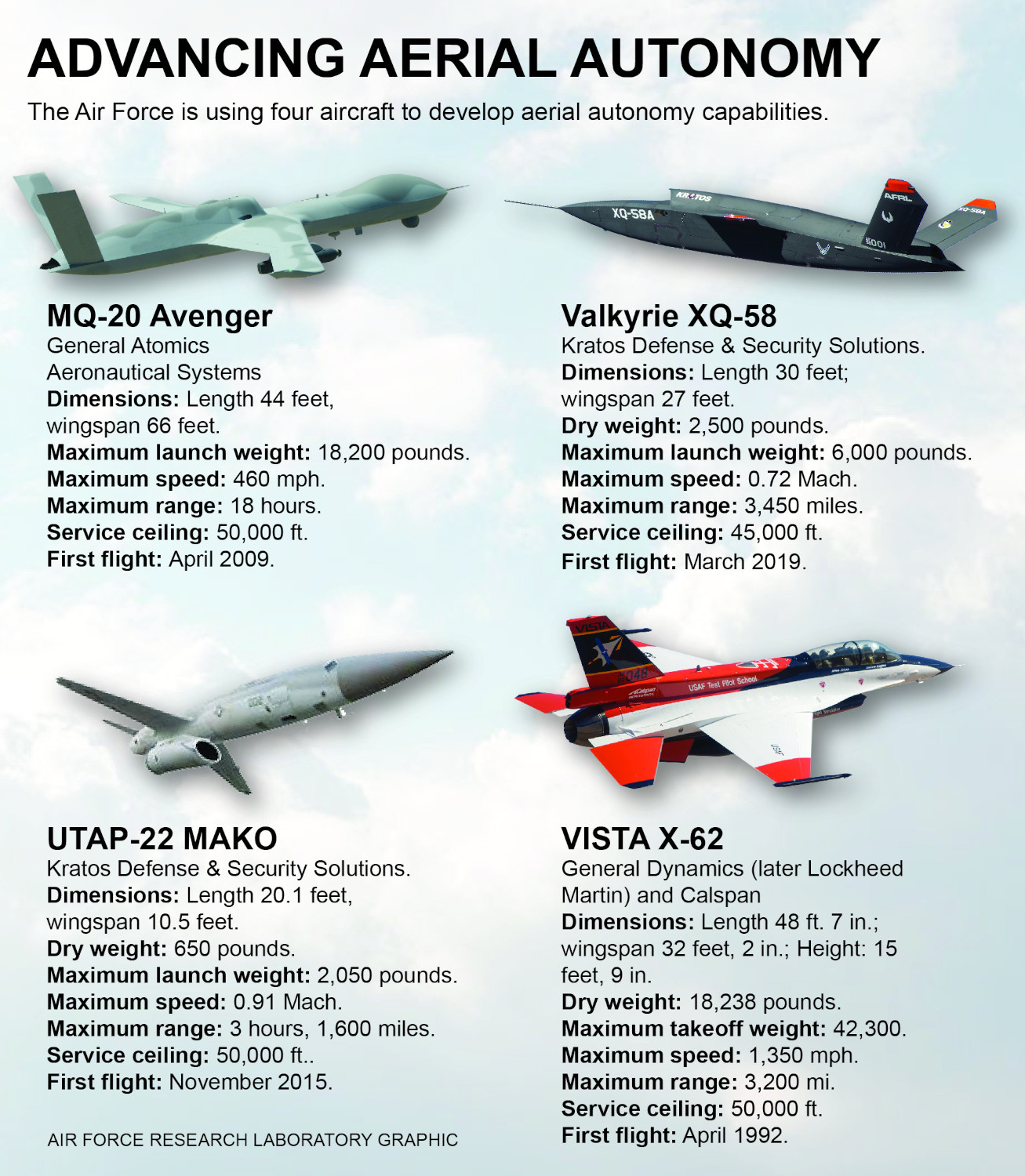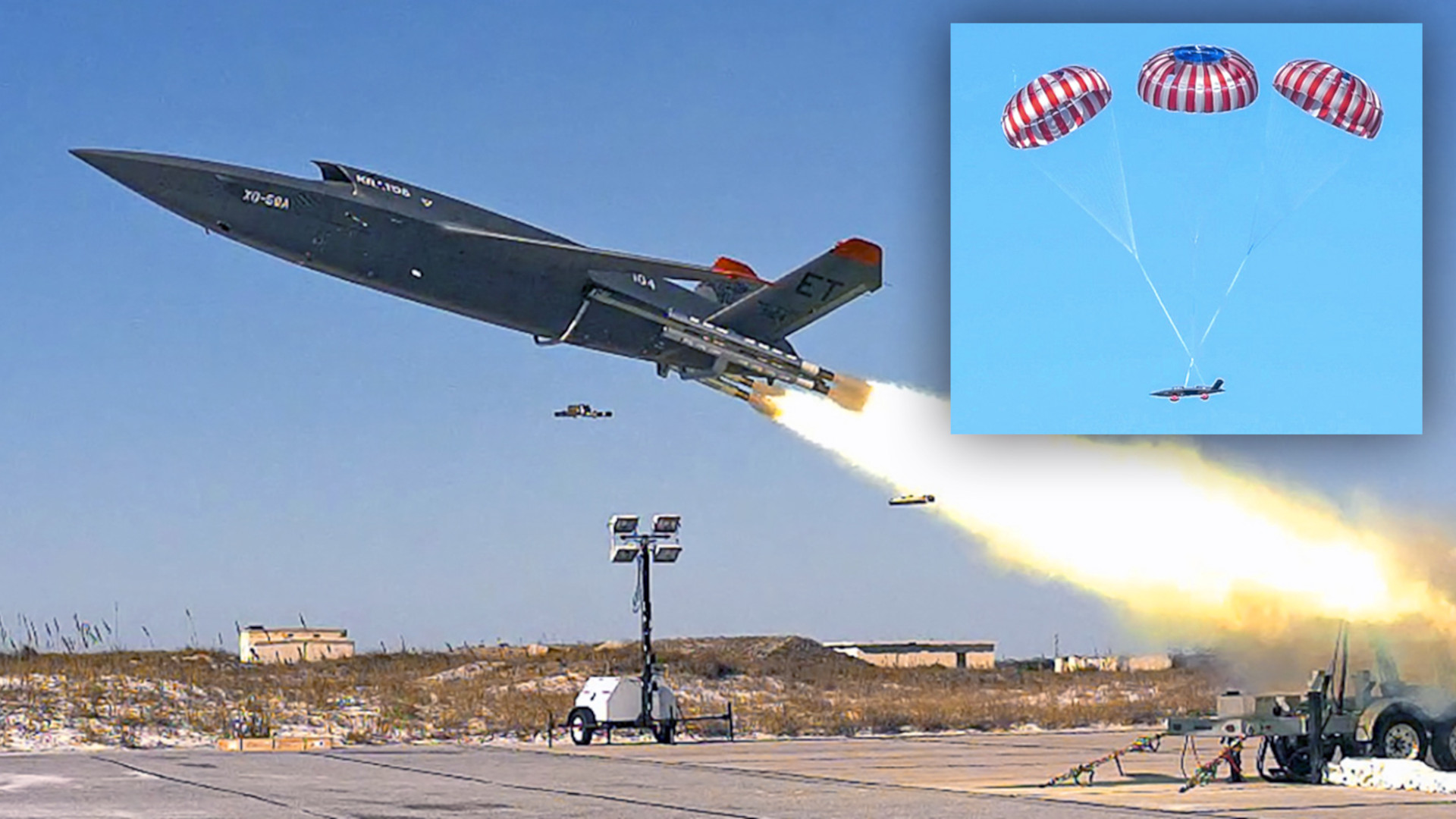The U.S. Air Force has released pictures showing one of its newest XQ-58A Valkyrie unmanned combat aircraft during a test flight last year. The images highlight the fact that the drone does not require a runway of any kind in order to get airborne or land at the end of a sortie. Runway independence could be very advantageous in future operational contexts where traditional air base infrastructure may be destroyed, damaged, or otherwise unavailable.
The test flight question involved an XQ-58A, tail number 22-104, launched from Eglin Air Force Base in Florida and took place on Dec. 15, 2022. However, the pictures were only posted online yesterday.

The captions to all five images in the set are the same and read as follows:
The Strategic Development, Planning and Experimentation and 40th Flight Test Squadron Autonomous Aircraft Experimentation team conducted an operational experimentation test flight of the XQ-58A here, Dec. 15, 2022.
Officials at Eglin announced last November that they had taken possession of a pair of XQ-58As, which were then assigned to the 40th Flight Test Squadron, as part of an expansion of autonomy-related flight testing activities there. It was unclear at the time whether these drones were new purchases from manufacturer Kratos or if they had been transferred from other units. The “22” in the tail number is the fiscal year (2022) in which it was purchased, showing that it is a relatively new acquisition.

It is still not clear whether or not the 40th Flight Test Squadron’s XQ-58As are examples of a new Block 2 subvariant with an expanded performance envelope, which Kratos revealed last year. The exact performance increase offered by the Block 2 configuration is unknown. The Valkyrie can be launched with a total weight of up to 6,000 pounds, reach an altitude of up to 45,000 feet above sea level, and fly out to a range of around 3,000 miles, according to the company’s website.
The Air Force has been working with examples of the XQ-58A, which made its first flight under the service’s auspices in 2019, for years now. The drones have been used for a variety of research and development and test and evaluation purposes since then.

The Valkyrie is intended to be attritable. This is a term that in military aviation generally refers to designs with a balance between unit price and capabilities that enables the use of a platform to be employed on riskier missions that might otherwise preclude the use of a more expensive complex ‘exquisite’ asset. The very first of the Air Force’s XQ-58As is now on display in a museum, highlighting this focus on affordability, as well as short service life.
As the captions to the new pictures underscore, the Valkyries now at Eglin are there primarily to support the Autonomous Aircraft Experimentation (AAx) effort, which is tied to the Air Force’s Skyborg project. Skyborg is centered on the development of an artificial intelligence (AI) driven “computer brain,” along with a suite of other systems and technologies, intended to enable drones, and potentially crewed platforms, with varying degrees of autonomous functionality.
The XQ-58A is one of a number of uncrewed and crewed aircraft that have been involved in Skyborg-related testing since 2021. This test fleet also includes Kratos’ smaller UTAP-22 Mako.

Skyborg and AAx are feeding into new Air Force efforts to acquire advanced drones with high degrees of autonomy that are designed to work collaboratively with crewed platforms. The development of these Collaborative Combat Aircraft (CCA) is part of the service’s larger Next-Generation Air Dominance (NGAD) effort, which also includes work on a sixth-generation crewed stealth combat jet, sensors, networking and battle management systems, weapons, advanced jet engines, and more, which you can read more about here.
The exact purpose of the December 15 test flight from Eglin is unclear, though one of the five pictures the Air Force released does show the XQ-58A flying in formation with an F-16C Viper fighter jet. Valkyrie has previously demonstrated its ability to stay in formation with crewed platforms in at least a semi-autonomous mode.

The other four XQ-58A images posted online yesterday focus on the launch and recovery of the XQ-58A. The drone uses a rocket-assisted takeoff method via a static ground-based launcher.

At the end of a mission, the Valkyrie flies to a set point, its engine cuts out, and a parachute recovery system is deployed. Inflatable airbags help cushion the aircraft when it touches down. The drone can then be recovered and made ready to fly again.

The XQ-58A’s total runway independence is an often overlooked capability of the design. It could be a very useful attribute for employing future variants or derivatives of the Valkyrie to support actual combat operations. Valkyrie in its present form is already a highly modular design and could be configured to perform a host of different missions, including strike, electronic warfare, intelligence, surveillance, and reconnaissance (ISR), and communications relay. It has a demonstrated ability to launcher smaller uncrewed aerial systems from an internal stores bay.

The lack of a need for a runway to support Valkyrie operations immediately drastically expands the areas from which Valkyries can be launched and recovered. This could allow them to be positioned closer to where they are expected to fly, potentially reducing the amount of time it might take for them to get there and increasing how long they can loiter once they arrive. In many instances, such as during a conflict in the Pacific, this could be critical to getting them within range of relevant target areas.
Kratos, which does regularly tout runway independence as a key feature of the XQ-58A’s design, has noted that this capability means the drones wouldn’t add to runway congestion during high-tempo operations, if launched from an airbase area, either.
On top of all this, the Valkyrie has a small operational footprint and is intended to be rapidly deployable, even to remote and austere locations. In the past, Kratos has shown a concept for a containerized transport system that includes an integrated launcher.
This is all particularly relevant to the Air Force’s new and still-evolving expeditionary and distributed concepts of operations, which are currently collectively referred to as Agile Combat Employment (ACE). Other branches of the U.S. military and foreign military forces are coming to similar conclusions about the need to operate, especially when it comes to aviation, in a more distributed manner to improve flexibility and reduce vulnerability.
The U.S. Marine Corps is also exploring new ideas about how to operate in expeditionary and distributed contexts, including a concept known as Expeditionary Advance Base Operations (EABO). EABO envisions relatively small, but diverse Marine forces being able to rapidly deploy, establish forward operating bases, and then just as easily reposition themselves as necessary. The central idea is this gives Marine commanders greater flexibility to help control littoral areas, and surrounding “seaspaces,” while also making it more difficult for opponents to react effectively to those movements.
The EABO concept is part of the Marine Corps’ larger Force Design 2030 initiative. This involves massive force structure changes, as well as doctrinal shifts, with a major focus on uncrewed systems, as The War Zone has explored in the past.

The XQ-58A’s runway independence and other capabilities may now come up as the Marine Corps looks to expand the scale and scope of its uncrewed aircraft capabilities. The U.S. Navy recently announced that it was buying two XQ-58As and it has since been clarified that it is the Corps that will actually be experimenting with them.
“This purchase is part of ongoing USMC efforts to look at future autonomous collaborative platforms,” Maj. Jay Hernandez, a Marine Corps Aviation spokesperson, told The War Zone in a statement last week. “The base contract was awarded primarily for the baseline aircraft – a decision for future modifications and operations has not been made as these aircraft are for experimental use.”
“Force Design 2030 provides a roadmap for transitioning the Marine Corps into a more agile expeditionary force. It is in Force Design’s guidance that the Marine Corps – and Marine Corps aviation – began the change to posture and force structure,” Maj. Hernandez added. “The Commandant [of the Marine Corps, Gen. David Burger,] set us on the path to several revolutionary changes: making us lighter and more agile; executing long-range fires not just in aviation but through the innovation of the Marine Littoral Regiment. This experimentation will help to inform the Marine Corps’ future and its uncrewed roadmap way ahead.”
Runway-independent drones would fit well with Force Design 2030’s EABO concept. The Marine Corps has already been experimenting with how it might rapidly deploy and redeploy contingents of vertical takeoff and landing-capable F-35B Joint Strike Fighters in a distributed manner between forward sites, as you can read more about here.
None of this work, at least as it stands now, is “connected to any other Air Force or Navy programs,” according to the Marine spokesperson.
All told, we can definitely expect to see more examples of Air Force and now Marine Corps testing involving XQ-58As highlighting the design’s runway independence and other capabilities.
Contact the author: joe@thedrive.com
